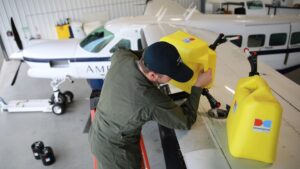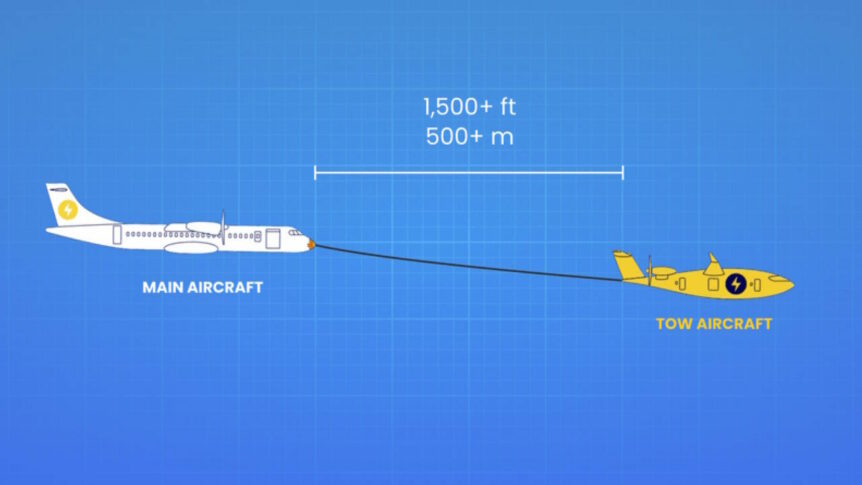Anpaire, a leader in hybrid aviation, announced it has just acquired two firms. Magpie Aviation, a somewhat audacious startup that has created a remarkable way of towing battery-powered electric airplanes hitherto unattainable distances. Ampaire also acquired Talyn Air, a startup offering an eVTOL (electric Vertical Take Off and Landing) solution to extending range. Both firms take unusual approaches to the problem.
It’s not like Ampaire doesn’t put enough mileage on its own hybrid aircraft – 25,000 at last count. Ampaire has flown its Cessna 337 push-pull twins in Hawaii, Scotland, and England and converted Cessna Caravans to Ampaire’s hybrid drive.
Adding range up to a thousand miles at a time, Magpie hooks up to an otherwise range-limited aircraft and can tag team the craft on multiple hookups.
On another front, Ampaire has also brought Talyn Air into the fold, using a lifting craft to take a cruise machine to launch altitude.
Add to the new airframe types Ampaire has included in its lineup, the company is testing sustainable aviation fuel (SAF) to lower the emissions of its internal combustion engines.
Ampaire and SAF
Ampaire replaced the Cessna Caravan’s original PT-6 turbine engine with its own AMP-H570 AMP Drive hybrid-electric propulsion unit. The company has been ground testing the hybrid system at Camarillo Airport in California February 14 with SAF derived from carbon dioxide. CEO Kevin Noertker explains that his firm’s hybrid technology, “actually empowers sustainable aviation fuels to be even more impactful.”
Quoted in AOPA Pilot, Nortker added, “Historically, aviation has been unkind to engines,” explaining that aircraft need phenomenal power for takeoff, but then throttle back significantly for cruise. “What that leaves in a traditional engine is an inefficient engine.”

SAF decreases emissions to essentially zero
In the case of Ampaire’s hybrid, “Pairing a combustion engine with an electric propulsion system amplifies the efficiency of SAF usage by two to three times.” Fuel used in ground testing was 100-percent ASTM D7566 Sustainable Aviation Fuel (SAF) produced by Dimensional Energy from electricity and carbon dioxide, the latter being abundant.
Ground testing to validate “the performance and viability of Dimensional Energy’s pure e-fuel SAF exceeded expectations,” according Ampaire. With Ampaire’s hybrid drive system already capable of 50- to 70-percent reduction in fuel emissions compared to the PT6 turboprop engines found in Cessna Caravans, the use of SAF doubles that already high efficiency and drops emissions to “near zero.”
Ampaire and Magpie
Green Car Congress reports Ampaire announced its acquisition of Magpie Aviation on March 4, 2024 for an undisclosed fee, the first of two technologies they purchased to extend the range of electric aircraft.
In 2023, Magpie demonstrated world’s first automated towing connections between two aircraft. Magpie has government and U. S. Air Force contracts which Ampaire will continue. This includes multiple pending Magpie patents and pending and existing government contracts. According to Ampaire, these will help it further develop Magpie’s solution, as well as its proprietary propulsion system.
Ex-Air Force pilot and Perlan Project Chief Pilot Jim Payne and Perlan pilot Tim Anderson flew test flights for Magpie over Nevada.
Payne explained, “I took off being towed by the Pipistrel Virus with the active hook on the nose of the PIK-20D sailplane. We towed to 10,000 ft. [above mean sea level], where I released. Tim Gardner then started about a 500-fpm descent in the Virus while I flew formation on the hook. When he was stable, I moved forward and made a connection. After each connection, he would tow me up about 1,000 ft., where I released and repeated the process. We did this three times on the first flight and five times on the second flight.”
Magpie is working on a larger tow vehicle, also capable of carrying a large payload itself. The twin-pusher Magpie MP-1 could tow battery powered regional airliners and is described in detail here.

Routes for the towed aircraft would resemble Magpie’s projection, and would expand the possibilities for low-cost extended-range tours.
Talyn Aviation
Talyn Air confesses something which has concerned your editor for some time: “The biggest problem with electric VTOL aircraft is the VTOL system. It’s a pain. The world-changing convenience of vertical lift systems comes with a high price tag: they weigh a heap, particularly because VTOL sucks up so much energy that you need a huge battery.”
That weight, and the lack of a usable glide ratio for many eVTOLs, compromise the range and safety of the vehicle. Talyn’s solution is to use a vertical lift vehicle only for lift-off and to release a high-speed cross-country vehicle which will be retrieved by another eVTOL at the end of the trip. Because it doesn’t use great amounts of energy to rise and descend, the high-speed machine can use smaller wings, better aerodynamics, and get the most out of its batteries, which will only require cruise power settings.
As noted, Talyn divides each flight into three phases. Comparing their technology to a two-stage rocket, Talyn notes that having a separate craft to lift the cruise vehicle to operating altitude ensures the journey starts of a 100-percent fully-charged battery.
Cruise mode enables “transporting up to 1000-lb payloads more than 300 miles at over 200 mph, a true regional solution.” The large battery capacity required to attain cruise altitude is left back with the liftoff vehicle, allowing large payloads.
Talyn co-founders, Jamie Gull and Evan Mucasey have tested this with quarter-scale models, and are now moving toward building full-scale prototypes for the the U. S. Air Force.
Arrival requires a hookup with a second lift vehicle, but, “The cargo arrives at its destination instead of requiring trucks, vans, or other secondary vehicles to complete the journey.” This latter element may actually save overall fuel or energy use.
Where To?
With so many choices available, one wonders how Ampaire will employ these new opportunities. Can the technologies be meaningfully employed together, or for separate missions, each of which has the potential of providing efficiency, utility and energy savings? Regardless, the future seems brighter because of the many options becoming viable.

